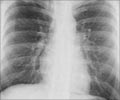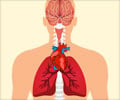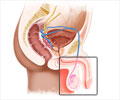Patients with active pulmonary tuberculosis infection, but, without HIV infection can be now be tested accurately for tuberculosis by a urine test.
- A noninvasive urine test can now detect active pulmonary tuberculosis (TB) infection in patients who do not have HIV.
- The test detects a sugar moiety called lipoarabinomannan (LAM) that is a marker for TB infection that the bacterium sheds into the urine.
- Hydrogel nanocages embedded with a chemical dye bait were used to trap LAM in order to increase its detection sensitivity by 100- to 1,000 fold.
Study
The scientists chose a high-affinity chemical dye bait which was a copper complex reactive dye called RB221 that they embedded in tiny hydrogel meshes to form structures called nanocages. Nanocages have the ability to detect cytokines and other antigens present in low concentrations in urine. The RB221 nanocages were used to trap LAM from urine, increasing detection sensitivity by 100- to 1,000 fold, while at the same time excluding interfering compounds from the samples that could give mixed results.Forty eight Peruvian patients were chosen, all with active pulmonary TB tested microbiologically, and none infected with HIV and none who had received treatment for TB. The pretreatment urine samples were collected from these patients and LAM was quantitatively measured in the urine as compared to non-TB, healthy and diseased (with other conditions), age-matched controls.
- TB infections were detected with greater than 95% sensitivity, with TB-positive, HIV-negative patients having detectably higher concentrations of LAM in their urine compared to the controls.
- The elevated LAM concentrations in the urine matched with increased body disease burden, meaning more LAM concentrations were found in patients who had higher degree of disease (as measured by the degree of patient weight loss, TB organism count in the cough, cough frequency and appetite).
Nanocages can also be used as a method to detect and monitor other infections making it a very versatile technology.
Tuberculosis
Tuberculosis (TB) is caused by the bacterium, Mycobacterium tuberculosis. The disease most often affects the lungs but can affect other body parts. It is a curable and preventable condition. The mode of transmission of the TB germs is through the air, spreading as people with lung TB cough, sneeze or spit.TB is listed as one of the top 10 causes of death worldwide. In 2016 there were 10.4 million people (including 1 million children) who had fallen ill with the disease and 1.7 million (including 250000 children) who succumbed to death because of the disease. TB was also the cause of 40% of HIV deaths in 2016. The highest mortality due to TB occurs in low- and middle-income countries, with India leading ahead. Hence, ideally, using a noninvasive body fluid such as urine for the test would be tremendously useful in a low-resource setting.
References:
- Luisa Paris, Ruben Magni, Fatima Zaidi, Robyn Araujo, Neal Saini, Michael Harpole, Jorge Coronel, Daniela E. Kirwan, Hannah Steinberg, Robert H. Gilman, Emanuel F. Petricoin III, Roberto Nisini, Alessandra Luchini, and Lance Liotta. Urine lipoarabinomannan glycan in HIV-negative patients with pulmonary tuberculosis correlates with disease severity. Science Translational Medicine 13 Dec 2017: Vol. 9, Issue 420, 2807 DOI: 10.1126/scitranslmed.aal2807
- Tuberculosis - (http://www.who.int/mediacentre/factsheets/fs104/en/)















